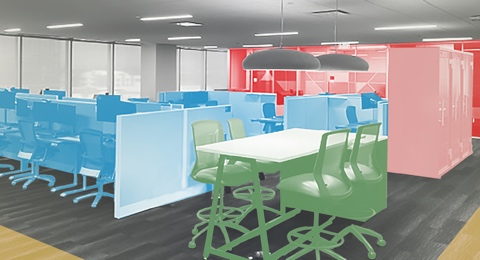Got Control Issues?

It might be time to just let it go!
“What doesn’t bend breaks.” “If you love something, set it free.” “You gotta roll with the punches.” Feel free to substitute your favorite “go with the flow” idiom here, because this month we’re thinking about workplace flexibility and the policies that govern everything from your mom-and-pop barber shop to the multinational corporation that your state wooed with millions in tax breaks. Intrigued? Take a break from your Earth Day celebrations and check out On Our Minds.
On our minds
We have always advocated for employee agency, which is, not-surprisingly, supported by science. Autonomous employees are happier and more engaged, which leads to higher productivity and lower turnover. Flexibility isn’t just about allowing employees to set their own schedules and work from their chosen location; it’s about providing various types of in-office workspaces, about being attentive to the sensory needs of a neurologically diverse workforce, and about letting go of traditional models that forced the majority of workers to conform and choose between their personal and work lives. Workplace flexibility is about focusing on worker comfort and well-being and understanding the integral role these things play in the overall success of any company.
For the past thirty years, organizations large and small have been experimenting with less-hierarchical workplaces. Different organizations use different terminology, but one approach to more horizontal management is holacracy, popularized by the late-CEO of Zappos, Tony Hsieh. Data tells us that corporations have reduced defects and errors (Volvo and Fed Ex), saved money (c), and increased productivity (General Mills) after trading traditional managers for self-managed teams. Often holacratic companies operate within the bounds of a constitution - a living document outlining goals, best practices, and policies - that everyone has a hand in shaping. Holacratic companies allow employees to adapt their duties to meet the company’s current needs, as well as to ensure that their duties align with their personal talents and skillset. Even with flat a organizational structure, clear goals and employee expectations are important. But micromanaging and unnecessary meetings are key reasons workers leave jobs. In contrast, flexibility is one of the reasons they stay. And the type of serendipity that leads to innovative breakthroughs can be engineered, to a degree, but it can’t be mandated from top-down.
Unfortunately, rather than offering better policies to engage their workforce, companies often double down on bad policies, attempting to keep employees via coercion and control. This spring, the Federal Trade Commission will decide whether to ban some of these coercive policies—noncompete clauses. Research shows that noncompetes lower US wages (to the tune of $300 billion a year), limit career opportunities, and make it difficult for workers to leave unsatisfying jobs. These clauses often prevent workers from starting their own business or seeking similar work within a certain geographic radius, for a specific length of time. In some instances, noncompetes cover areas less than 100 miles; in others, they encompass entire states or continents. If a worker violates the terms of their contract, the company may sue for damages.
Furthermore, noncompetes are no longer limited to senior level employees. The FTC estimates that they affect one-in-five US workers. They are common among hairdressers, security guards, salespeople, deli employees, and warehouse, factory and healthcare workers. Sometimes workers must drive hours each day or even relocate, so as to not violate the terms of their contract.
In addition to limiting employee agency, noncompetes hamper market competition. In a small market, a company with high-employee turnover and a lengthy noncompete could tie up an entire labor force, driving competitors out of business. There are other, more effective ways to protect trade secrets, such as copyrights, nondisclosure, and non-solicitation agreements. Rather than treating the employee as property, these types of protections target intellectual property.
Nine states already limit noncompete clauses, to workers making at least six-figures. Two states ban noncompetes in certain industries, like healthcare; and in three states, noncompetes are not enforceable. But other policies play similar roles; fittingly, one of these is known as TRAP (Training Repayment Agreement Policies). Once found only in high-paying jobs, now these policies affect service industry and retail workers, transportation, healthcare workers, and employees in numerous other industries. They force employees to reimburse their employer for “training,” should they leave before a certain time passes. Another type of clause, liquidated damage provisions, force employees to pay their employers significant sums of money if they leave before a certain period or sometimes, if they leave at all. The FTC is considering making all of these types of policies illegal—or rather, any policy that effectively functions as a noncompete agreement.
Kudus to the FTC for taking this step, but frankly, good employers don’t need the FTC to police their practices and policies. Strong leaders already know that you catch more with honey than vinegar, and you keep good workers by recognizing their humanity—treating them as creative and capable beings, with rich lives that extend beyond the office—rather than trying to constrain them with archaic, absolutist rules and procedures.
From the archives
Last April, we were looking for silver linings and thinking about how COVID transformed our offices for the better. In April of 2021, we were looking at hospitality industry practices and what they could teach us about hybrid work and pondering what we lose, when we lose water-cooler banter. Two years ago, we all were still trying to find our footing in a work landscape that transformed overnight, but we were already talking about how this could lead to a smaller corporate real estate footprint and how important it is for space to be flexible.
We’ve been talking about workplace flexibility, but we’re big proponents of physical flexibility, as well. To this end, perhaps some of your newly-flexible office space could double as a yoga room? Check out Adriene Mishler’s free, accessible yoga videos. There’s a reason she’s the most popular YouTube yogi. Cheers to flexibility in all its forms!
In Case You Missed It
Last month we talked about the Show Up Act. If you’re not sure what that is, check out our March newsletter. Take a peek at these articles, to catch up on other workplace news you may have missed.

Your Workplace is a Dynamic Lab
If you want to improve your workplace, you’ve got to run tests in real time – and then figure out how to upscale what works. We talked “how and why” in our most recent PLASTARC webinar.

Sleep Rooms: Cozy or Creepy?
Heading back to the office but need a bit of rest and respite? Make sure to check out the expanding world of VR sleep rooms, coming soon to a pod near you.

Flex-Space is the Best Space
PLASTARC has been helping LPL Financial refresh their workplace experience, from traditional to long-term hybrid, with more flexible in-office spaces. Read all about it here.

ATB Goes ABW
PLASTARC recently helped ATB, Alberta’s largest financial institution, shrink their real estate footprint and transform their office into a true activity-based workspace, via tech upgrades, new policies, and multi-sensory design.

PropTech is SmartTech
We attended Pratt School of Architecture’s first PropTech conference, to talk facilities management, building life cycles, and more.

Purpose Over Ego
David Chipperfield was just announced as the 2023 Pritzker Prize Winner. But what makes his architecture so special?
Looking Ahead
Put a little spring in your step as you head to these in-person and virtual events ahead! Check out these exciting opportunities in the coming weeks.





